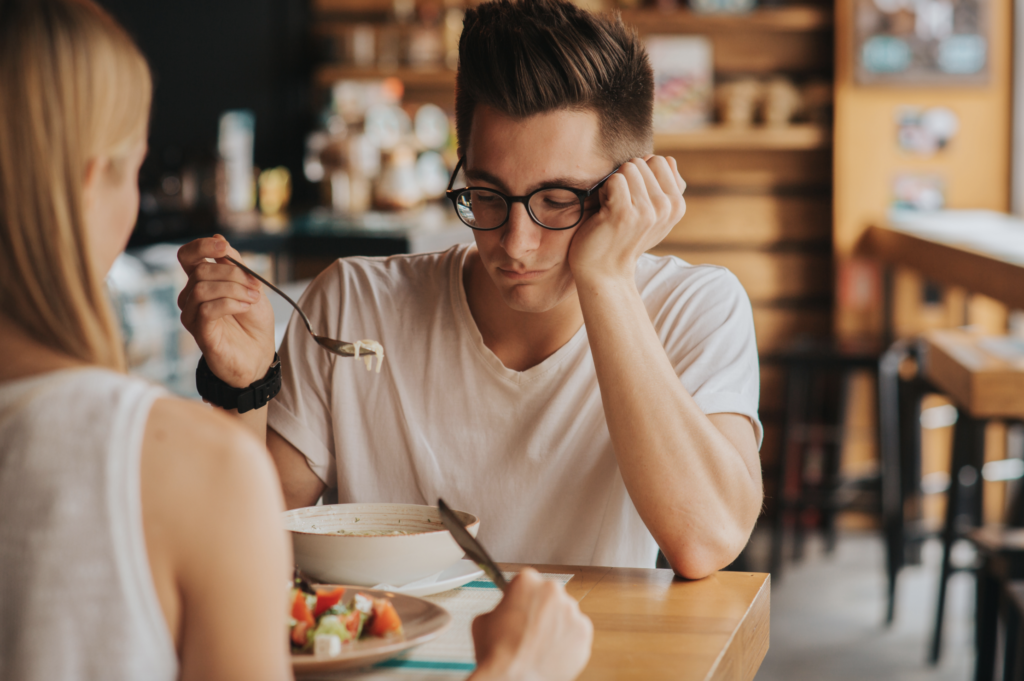Eating Disorders
Eating disorders are conditions that affect a person’s perceptions of their body, weight, and health. As a result, a person may engage in unhealthy behaviors to control their weight, such as vomiting or refraining from eating regular meals.
Different eating disorder types exist. It’s possible that a person can progress from one eating disorder, such as anorexia, to another, such as bulimia. A person may also not recognize their behavior as a true problem that can have deadly effects if left untreated.

ANOREXIA NERVOSA
This condition causes a person to severely restrict their eating, often due to an intense fear they will gain weight. Over time, they may start to appear extremely thin with brittle nails and hair as well as muscle wasting.
BINGE EATING
People who suffer from a binge-eating disorder have episodes where they engage in uncontrolled eating in a short amount of time. A person will often feel embarrassed or ashamed of their eating and may often eat in secret. People who engage in binge eating are often overweight.
BULIMIA NERVOSA
This condition causes a person to engage in binge-eating behaviors that are then followed by vomiting episodes. People with bulimia nervosa aren’t always thin. They are often dehydrated and may have worn tooth enamel as well as a chronically inflamed sore throat.
EATING DISORDERS
Common Misconceptions
Many people don’t understand the true severity of eating disorders. According to the National Institute of Mental Health, anorexia nervosa has the highest mortality rate of any mental health disorder. In addition to complications from eating disorders, those with the condition also commit suicide.
Eating Disorder Means Skinny
Another misconception about a person with an eating disorder is that the person will be extremely emaciated. While it may be true that some people with eating disorders are extremely underweight, this is not always the case. A person can be a normal weight or overweight and still suffer from an eating disorder.
Eating Disorder Means Skinny
Some people also perceive that eating disorders only affect women. It is true that women experience eating disorders in higher numbers than men. However, men experience a greater proportion of binge-eating disorders than when compared to other eating disorders, such as anorexia or bulimia, according to the National Institutes of Health.
Are Eating Disorders Addictions?
Several medical experts have compared eating disorders to an addiction. For example, a person who has anorexia nervosa may continue to starve themselves and deny themselves food, even at great physical and emotional costs to themselves. According to an article in the journal Current Drug Abuse Reviews, the more severe a person restricts their calorie intake, the more likely it is they use psychostimulants, such as cocaine.
Eating Disorders
• Long Term Goal of Unattainable Weight
• Exerts Control Over Body
• Receives Positive Social Feedback
• Thinks Nothing is Wrong
Similarities
• Starts in Adolescence
• Interferes with Daily Life
• Causes Preoccupation
Substance Use Disorders
• Short Term Goal of Using
• Lost Control Over Substances
• Receives Negative Social Feedback
• Desire to Stop Using
Similarities
There are also additional similarities between addictions and eating disorders. For example, both substance abuse problems and eating disorders begin in a person’s adolescent years. Also, a person with an eating disorder often becomes so wrapped up in their disorder that their behaviors start to interfere with their activities. For example, a person may become so secretive in restricting their food intake or exercising excessively that they refrain from attending social events. In a similar manner, a person may miss appointments and withdraw from others when they suffer from substance abuse.
Another common aspect between the two conditions is a preoccupation with something. For example, a person who is addicted to a substance is preoccupied with when they can use a substance again. Similarly, a person with an eating disorder is often preoccupied with thinking about how they can “not” eat or obsessing about ways they could binge and purge.
Differences
While there are some aspects of an eating disorders that may resemble an addiction, there are key differences as well. For example, someone struggling with substance abuse is often seeking their next high. Those who have an eating disorder may be seeking an immediate weight loss, but they are also pursuing a long-term goal of thinness or weight control. Control is another major difference between substance abuse and eating disorders. When a person suffers from substance addiction, they lose control over their relationship with the substance. Conversely, those who suffer from eating disorders are often attempting to gain control over an aspect of their lifestyle, such as their eating or their body image. Additionally, consequences from a cultural and society perspective are different when a person struggles with an eating disorder versus a substance abuse addiction. For example, those who are addicted to drugs are perceived negatively in society. However, in Western cultures, many people value thinness. Before a person realizes that there is a struggle with an eating disorder, they may actually compliment or envy a person’s thinness. This can further perpetuate and reward a person’s behavior. Another difference is the mindset of a person who struggles with an eating disorder versus substance abuse. Although there are certainly exceptions, many people who struggle with substance abuse express a desire to stop using drugs, yet have strong physical and mental cravings that may cause them to relapse. Eating disorders are traditionally very difficult to treat because many people take pride in their ability to lose weight or maintain a very low weight or may not even believe that there is an issue.
How Often Do Addiction and Eating Disorders Co-Occur?
According to the National Eating Disorders Association, an estimated 50 percent of people with an eating disorder abuse alcohol or illicit drugs. This is a much higher rate of substance abuse than the general population.
Researchers have found that when a person restricts their food, the reinforcement of substance abuse is heightened. A person may find greater pleasure in using substances such as cocaine or methamphetamine when they restrict their food.3 Researchers have also been able to re-create this effect in laboratory rats.
Substances that are most abused by those with eating disorders include:
- Alcohol
- Amphetamines
- Cocaine
- Heroin
- Laxatives
ANOREXIA AND SUBSTANCE ABUSE
Research regarding those with eating disorders and substance abuse has revealed that anorexia nervosa is a common disorder that starts before a person starts their substance abuse. This suggests that some people may abuse substances as a means to lose more weight or control their appetite. Doctors also know that people who have an eating disorder before a substance abuse problem typically have an earlier onset of an eating disorder when compared to someone who does not.

Doctors have identified risk factors for both conditions that can make a person more likely to experience an eating disorder and substance abuse problem. Risk factors include a family history of either condition and a history of mental health disorders such as anxiety, depression, or compulsive behavior. They have also identified that some changes in a person’s brain chemistry may influence the likelihood a person will experience a substance abuse disorder as well as an eating disorder. Examples of these chemicals include serotonin, dopamine, and gamma-aminobutyric acid or GABA.
Differences Between Eating Disorders and Addiction That Impact Recovery
ADDICTION RECOVERY
Treating eating disorders and addiction represents unique challenges to a recovery professional. However, neither is impossible to treat. For example, the treatment for substance abuse disorder is to avoid the substance.
EATING DISORDER RECOVERY
However, a person who suffers from an eating disorder cannot avoid food. A person who struggles with an eating disorder must learn how to engage in behaviors that may seem every day for many people – including sitting at a dinner table or eating in public. Also, it’s common for someone who struggles with an eating disorder to closely tie their self-worth with their body image. It is difficult for them to separate their sense of identity from their weight.

What Are the Most Effective Treatments for Co-Occurring
Addiction and Eating Disorders?
A person can usually receive the most effective treatments for co-occurring addiction and eating disorders at a facility that treats both conditions at the same time.4 Research has shown if a person seeks treatment for one condition at a facility, then goes to another facility for their other condition, they often end up in a cycle of remission and relapse.
UNDERSTANDING RELAPSE
What is perhaps most important is that a person and their friends and family understand that addiction and substance abuse treatments require a long-term process.
An estimated 25 percent of people who receive quality treatment will improve in both conditions and do well for the rest of their lives.
An estimated 50 percent will fall into a relapsing and remitting cycle while 25 percent will continue to struggle with their conditions.
EFFECTIVE THERAPIES
Treatments for both substance abuse disorders and eating disorders may involve a combination of medication administration and psychological support. Cognitive-behavioral therapy is a popular and often effective approach for treating eating disorders. According to the National Institutes of Health, this is often via a three-pronged approach.
First, a person receives education on an eating disorder as well as how to recognize thoughts and behaviors that could be harmful to a person with an eating disorder. They may also participate in nutritional counseling as well a monitoring.
The second phase is to further challenge a person’s Mal-adaptive behavior and find ways to change their behavior. The third phase involves learning techniques to prevent relapse and continue healthy behaviors.
Resources
- https://www.nimh.nih.gov/health/topics/eating-disorders/index.shtml
- https://web.archive.org/web/20210713185246/https://www.nationaleatingdisorders.org/substance-abuse-and-eating-disorders
- https://www.ncbi.nlm.nih.gov/pmc/articles/PMC4438277/
- https://pubs.niaaa.nih.gov/publications/arh26-2/151-160.htm
SAFE HARBOR TREATMENT CENTER
Finding Help at a Depression Treatment Center in Orange Country
If you or a loved one is struggling with an eating disorder or substance use disorder, seeking treatment at a facility that specializes in treating co-occurring disorders can be vital to long-term success. Many substance abuse treatment facilities will also screen for eating disorders as part of their admissions process. This can help identify a part of behavior that may be further contributing to addiction and impairing health.

